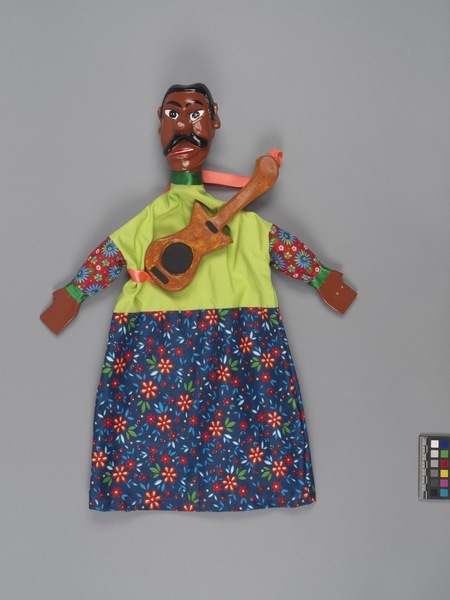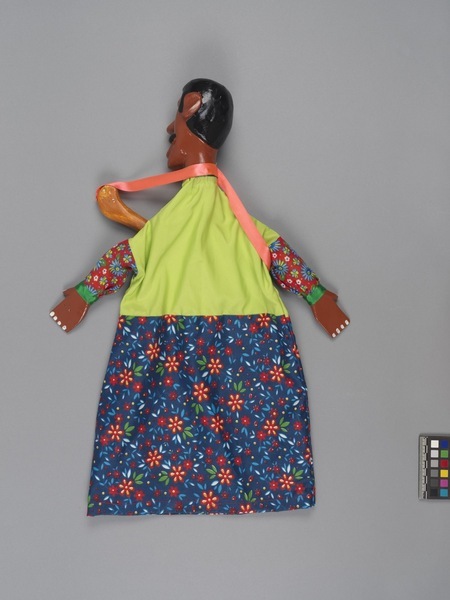Hand Puppet Item Number: 3381/6 from the MOA: University of British Columbia


Description
Mamulengo hand puppet of a 'Tapagé de Cachoeira' character. Head and hands are carved from wood and painted. He has dark brown skin, slanted oval black eyes, small rounded eyebrows, a large nose, large black moustache, and a closed mouth. His fabric body / tunic is light green. The sleeves are a red fabric with large blue flowers, and small white and green flowers, and the skirt is dark blue with red flowers and green or blue leaves. The fabric is adhered(?) to the hands and head, and wrapped with shiny dark green ribbon at the wrists and neck. He holds a small string instrument in his right hand, which has a pink-red strap that extends over his left shoulder. Operated by inserting a hand inside the body of the puppet to control its head and movements.
History Of Use
The puppet represents a character from a form of popular puppet theatre, found in northeastern Brazil, called mamulengo. This type of theatre is prevalent in disenfranchised communities with ancestral ties to colonized Indigenous peoples and uprooted, enslaved Africans. Mamulengo performances are entertaining events that can last all night long, with puppeteers (mamulengueiros) using 70 to 100 puppets in one staging. The stages are pop-up stands (empanadas), made of brightly coloured, floral-printed cloth. The shows consist of short sequences (passagens), or skits from popular stories that expose the inequalities and dramas of everyday life, profiling stock characters such as rich landowners and peasant labourers. The whole is spun together with humour, satire, lively music, and audience commentary.
Item History
- Made by Jose Edvan Ferreira de (Maker) in Gloria do Goita, Pernambuco, Brazil during 2018
- Owned by Associacao Cultural de Amigos do Museu de Folclore Edison Carneiro before July 25, 2019
- Received from Associacao Cultural de Amigos do Museu de Folclore Edison Carneiro (Seller) and Museum of Anthropology Exhibitions Budget (Funding source) on July 25, 2019
What
Who
- Culture
- Brazilian
- Creator
- Jose Edvan Ferreira de (Maker)
- Previous Owner
- Associacao Cultural de Amigos do Museu de Folclore Edison Carneiro
- Received from
- Associacao Cultural de Amigos do Museu de Folclore Edison Carneiro (Seller) and Museum of Anthropology Exhibitions Budget (Funding source)
Where
- Holding Institution
- MOA: University of British Columbia
- Made in
- Gloria do Goita, Pernambuco, Brazil
When
- Creation Date
- during 2018
- Ownership Date
- before July 25, 2019
- Acquisition Date
- on July 25, 2019
Other
- Condition
- good
- Accession Number
- 3381/0006